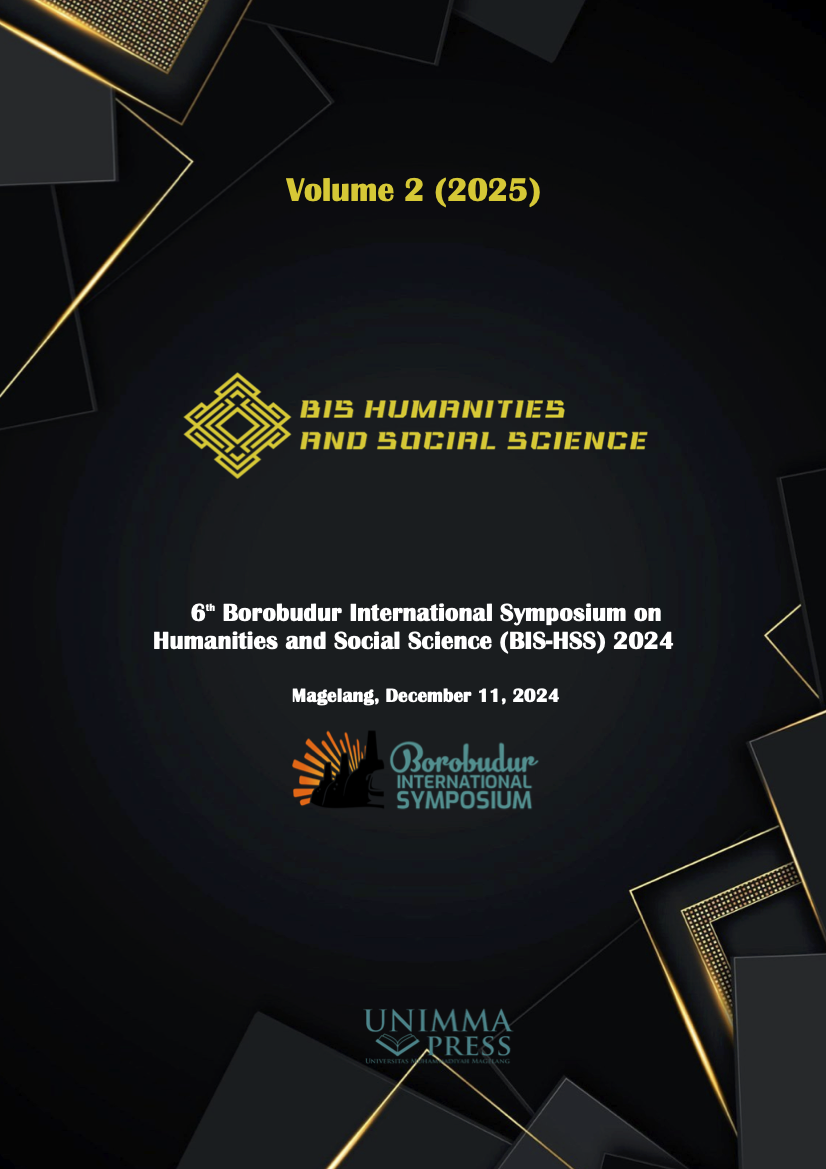Reimagining corporate branding in a digitally interconnected society: Challenges and opportunities for GRID network
Keywords:
Branding, Digital society, Media company, Rebranding, Interconnected societyAbstract
This study examines the rebranding process of GRID Network, as part of Kompas-Gramedia (KG) media group, adapting digitally to this technology disruption. GRID network needs to cater technological and behavioral change in order to survive in this era, thus reimagining corporate branding in KG print media Group, is a necessity. Aims of this study is specifically to identify internal and external response to challenges during the rebranding of GRID Network and generally to assess the impact of digital transformation on brand equity and consumer loyalty within Indonesia’s magazine and tabloid case within a digitally interconnected society. This article attempts to focus on a single case-study through qualitative interviews with employees across management, comparing and confirming the branding and rebranding conceptual framework. The main findings show that GRID Network's brand strategy, initially reactive to digital trends, may lack the strategic depth needed to build a unique identity, as it appears focused more on adapting to the interconnected, digital landscape than on establishing a cohesive brand image. This cautious entry into digital media may impact both employee alignment and consumer perception, with both groups potentially struggling to find relevance and consistency in the brand’s message. Recommendations include developing a unified brand identity that integrates core values, engages employees, and effectively bridges generational differences among consumers would help create a stronger brand presence and foster loyalty by aligning GRID Network’s digital transformation with clear, cohesive values that resonate across all audiences.
References
[1] B. Merrilees and D. Miller, “Principles of corporate rebranding,” Eur J Mark, vol. 42, no. 5–6, pp. 537–552, 2008, doi: 10.1108/03090560810862499/FULL/XML.
[2] L. Muzellec and M. Lambkin, “Corporate rebranding: Destroying, transferring or creating brand equity?,” Eur J Mark, vol. 40, no. 7–8, pp. 803–824, 2006, doi: 10.1108/03090560610670007/FULL/XML.
[3] Moisescu and O. Ioan, “Aspects regarding rebranding strategies - A conceptual and practical approach,” MPRA Paper, 2006, Accessed: Dec. 20, 2024. [Online]. Available: https://ideas.repec.org/p/pra/mprapa/32016.html
[4] T. C. Melewar, M. Gotsi, and C. Andriopoulos, “Shaping the research agenda for corporate branding: Avenues for future research,” Eur J Mark, vol. 46, no. 5, pp. 600–608, May 2012, doi: 10.1108/03090561211235138.
[5] L. de Chernatony and F. D. Riley, “Defining A ‘Brand’: Beyond the Literature With Experts’ Interpretations,” Journal of Marketing Management, vol. 14, no. 5, pp. 417–443, Jun. 1998, doi: 10.1362/026725798784867798.
[6] “Aaker, D. A. (1991), Managing brand equity: Capitalizing on the value of a brand name, New York: The Free Press.” Accessed: Dec. 20, 2024. [Online]. Available: https://www.sciepub.com/reference/244739
[7] J.-N. Kapferer, Strategic Brand Management: Creating and Sustaining Brand Equity Long Term. Kogan Page, 1997. Accessed: Dec. 20, 2024. [Online]. Available: https://books.google.com/books/about/Strategic_Brand_Management.html?hl=it&id=g6m_L8PYaLYC
[8] K. L. Keller, Strategic Brand Management: Building, Measuring, and Managing Brand Equity. Pearson Education, 2010.
[9] D. H. Assegaff, Jurnalistik masa kini: pengantar ke praktek kewartawanan. Ghalia Indonesia, 1983. Accessed: Dec. 20, 2024. [Online]. Available: https://lib.ui.ac.id
[10] C. Arndt, “Tabloid Journalism in South Africa by H. Wasserman Bloomington, IN: Indiana University Press, 2010. Pp. 218, £16·99 (pbk). - Starring Mandela and Cosby: media and the end(s) of apartheid by R. Krabill Chicago, IL: University of Chicago Press, 2010. Pp. 199, £13·50 (pbk). - Political Economy of Media Transformation in South Africa edited by A. Olorunnisola and K. G. Tomaselli Cresskill, NJ: Hampton Press, 2011. Pp. 304, £27·50 (pbk).,” J Mod Afr Stud, vol. 50, no. 4, pp. 722–725, Dec. 2012, doi: 10.1017/S0022278X12000419.
[11] D. Miller, B. Merrilees, and R. Yakimova, “Corporate rebranding: An integrative review of major enablers and barriers to the rebranding process,” International Journal of Management Reviews, vol. 16, no. 3, pp. 265–289, 2014, doi: 10.1111/IJMR.12020.
[12] A. Daly and D. Moloney, “Managing Corporate Rebranding,” Irish Marketing Review, vol. 17, no. 1/2, pp. 30–36, 2004.
[13] J. Gustafsson, “Single case studies vs. multiple case studies: A comparative study,” 2017, Academy of Business, Engineering and Science of Halmstad University.
[14] T. C. Melewar and E. Jenkins, “Defining the Corporate Identity Construct,” Corporate Reputation Review, vol. 5, no. 1, pp. 76–90, Apr. 2002, doi: 10.1057/PALGRAVE.CRR.1540166.
[15] M. Jo Hatch and M. Schultz, “Bringing the corporation into corporate branding,” Eur J Mark, vol. 37, no. 7–8, pp. 1041–1064, Aug. 2003, doi: 10.1108/03090560310477654/FULL/XML.
[16] J. M. T. Balmer and E. R. Gray, “Corporate brands: what are they? What of them?,” Eur J Mark, vol. 37, no. 7–8, pp. 972–997, Aug. 2003, doi: 10.1108/03090560310477627.
[17] M. A. Ramos, S. Andersson, and U. Aagerup, “Rebranding after international acquisitions: challenges of legitimation in emerging and developed countries,” International Marketing Review, vol. 41, no. 7, pp. 84–116, 2024, doi: 10.1108/IMR-02-2023-0019/FULL/PDF.
[18] M. C. Suchman, “Managing Legitimacy: Strategic and Institutional Approaches,” The Academy of Management Review, vol. 20, no. 3, p. 571, Jul. 1995, doi: 10.2307/258788.
[19] T. C. Melewar and E. Karaosmanoglu, “Seven dimensions of corporate identity: A categorisation from the practitioners’ perspectives,” Eur J Mark, vol. 40, no. 7–8, pp. 846–869, 2006, doi: 10.1108/03090560610670025.
[20] S. Nana, R. T.- Mamina, N. Chiliya, and E. T. Maziriri, “The impact of corporate rebranding on brand equity and firm performance,” Journal of Business & Retail Management Research, vol. 13, no. 04, Jul. 2019, doi: 10.24052/JBRMR/V13IS04/ART-08.
[21] V. Collange and A. Bonache, “Overcoming resistance to product rebranding,” Journal of Product and Brand Management, vol. 24, no. 6, pp. 621–632, Sep. 2015, doi: 10.1108/JPBM-10-2014-0730.
[22] C. Vallaster and L. De Chernatony, “Internal brand building and structuration: The role of leadership,” Eur J Mark, vol. 40, no. 7–8, pp. 761–784, 2006, doi: 10.1108/03090560610669982/FULL/XML.
[23] V. Tarnovskaya and G. Biedenbach, “Corporate rebranding failure and brand meanings in the digital environment,” Marketing Intelligence and Planning, vol. 36, no. 4, pp. 455–469, May 2018, doi: 10.1108/MIP-09-2017-0192.
Downloads
Published
Conference Proceedings Volume
Section
License

This work is licensed under a Creative Commons Attribution-NonCommercial 4.0 International License.

